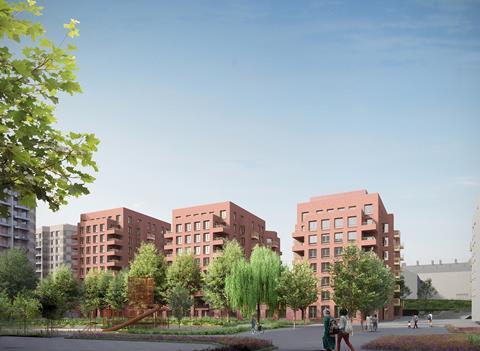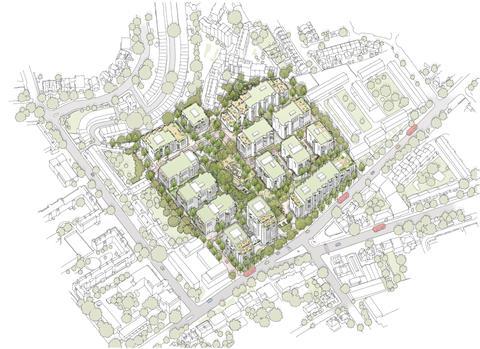Campaigners argue AHMM-designed scheme is a missed opportunity for not involving women

AHMM has revealed proposals for nearly 1,000 homes for Peabody on the four hectare former Holloway Prison site in north London.
The Ministry of Justice sold the site in 2019 to Peabody for £80m as part of a wider strategy to sell off prisons on valuable central London sites. The Greater London Authority lent the housing association £42m and the mayor of London said 60% of the homes built would be “genuinely affordable”. Just over 40% of these will be for social or target rent, Peabody said.
The car-free scheme, revealed today, is for 980 homes, a 0.6ha park and what is being called a Women’s Building. This 1,400sq m community facility will offer support services as an acknowledgement of the site’s history, said Peabody.
Holloway was western Europe’s largest women’s prison – and one of Britain’s most famous jails – before its closure in 2016. Dozens of suffragettes were incarcerated there as well as Moors murderer Myra Hindley and Diana Mitford, wife of the fascist leader Oswald Mosley. Five women were executed there including Ruth Ellis, the last woman to be judicially hanged in Britain. Oscar Wilde was an inmate before it became a women’s prison.
However, the redevelopment has been criticised by campaigners as a “missed opportunity” for not involving women in the design and construction.
Campaigners Reclaim Holloway and others criticised the decision to make the Women’s Building a single storey under a residential block.
Helen Aston, a senior lecturer at Manchester School of Architecture, said it was “dismissive, arrogant, and patronising” that the design process was not being carried out by a female-led architectural practice.
The current plans were “a totally lost opportunity”, she added, speaking at a recent event at the London Festival of Architecture.
Sarah Akigbogun, vice-chair of Women in Architecture UK and founding director at Studio Aki, called it “another example of the marginalisation of women’s needs but also of women in the construction and the procurement processes”.
Sarah Wigglesworth, founder of Sarah Wigglesworth Architects which is based near the site, said: “Women should design and build this building. This would empower and skill-up a generation of construction professionals and show that construction is a viable – even desirable – occupation for girls and women.”
In a blog on the subject she also argued for some of the building to be reused partly to save carbon and partly so future generations could better understand the site’s history.

Simon Allford, executive director of AHMM and RIBA president-elect, said their early designs had been revised following public consultation.
“The vision for Holloway is to provide high-quality homes and spaces that are connected into the surrounding area and to retain the green heart of the existing landscape and trees,” he said.
“The scheme has evolved in response to feedback, and we now have a lighter, brighter scheme, with distinct but complementary architectural styles through the development.”
AHMM leads the masterplanning team. Landscape architect is Exterior Architecture. The scheme is being delivered in partnership with developer London Square
Peabody’s executive development director, Dick Mortimer, said: “The Women’s Building will … be a vital part of the neighbourhood and we’re looking forward to more discussions around how we can recognise the legacy of the place throughout the design of the wider scheme.”
Holloway was originally built in 1848-1851 around a star-shaped plan but was rebuilt between 1968 and 1983 in line with more progressive principles.










No comments yet